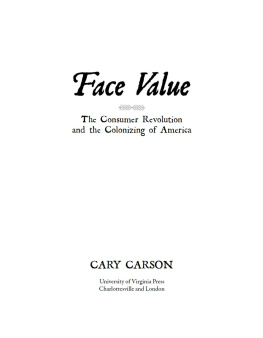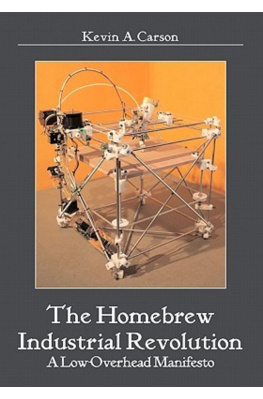University of Virginia Press
2017 by the Rector and Visitors of the University of Virginia
All rights reserved
Printed in the United States of America on acid-free paper
First published 2017
ISBN 978-0-8139-3936-0 (cloth)
ISBN 978-0-8139-3937-7 (paper)
ISBN 978-0-8139-3938-4 (ebook)
9 8 7 6 5 4 3 2 1
Library of Congress Cataloging-in-Publication Data is available from the Library of Congress.
Cover art: Portrait of Elizabeth Boush, by John Durand, Norfolk, Virginia, 1769, oil on canvas. (The Colonial Williamsburg Foundation, Museum Purchase, accession #1982-271)
To the memory of Barbara Gilbert Carson My teacher too
Nowhere in the world has shared culture been a more imperative requirement than in America. More than 300 million people live here, and they had descended over the course of a very few generations from a huge number of disparate cultures, with different histories, ways of behavior, worldviews and experiential backgrounds. All of them, sooner or later, had been required to relinquish their old culture and enter the new one. That must be why the most striking thing about the United States [today is] its sameness.
Karl Ove Knausgaard, My Saga, Part 2,
New York Times Magazine, March 11, 2015
Preface
This book marks the second coming of this essay. It debuted more than twenty years ago in a collection of papers that was presented first at a U.S. Capitol Historical Society symposium in Washington, D.C. After that meeting, Ronald Hoffman, the conference organizer, encouraged the authors to revise and expand their talks for publication. I am afraid that I took liberties with Hoffmans invitation and later his forbearance. Having much more I wanted to say and a daytime job that left too few hours to write an entire book, I jumped at the chance to piggyback a novella-sized treatise on top of an otherwise respectable collection of conference proceedings. My chapter tipped the scales at 215 printed pages! Whether that burden fatally weighed down the volume is hard to say. But the collected essays, entitled Of Consuming Interests, soon went out of print and dropped out of sight.
Curiously that was not the end of it, however much deserved. As the years went by, I occasionally heard rumors that my contribution, Why Demand?, was alive and well and leading an underground life as a bootleg facsimile that popped up here and there on college syllabi. Along the way it acquired a reputation. It became what one colleague termed a cult classic. The cultists were mostly teachers and students of architectural and decorative arts history and American and material culture studies. Eventually even they could no longer find secondhand copies to Xerox and scan. It was then that teachers and colleagues began urging me to consider updating the material and reprinting the oversized essay as a stand-alone publication. To humor them and, as I will explain in a moment, to try again to reach an audience that had largely missed the original publication, I approached the University of Virginia Press, the original publisher, by then under new management. The encouragement I received led to the comeback book that follows.
Out of print is not reason enough to reprint. Scholarship moves on. So has the scholarship that stands behind this revision. Historians, archaeologists, architectural historians, curators, and students of material culture have added depth and breadth to subjects that I could only touch on or guess at twenty years ago. I have adjusted my retelling of the story accordingly and cited these newer works in the endnotes.
Otherwise the organization of the book remains much as before for good reason. However much the original essay has enjoyed classroom use in the years since its initial publication, back then I was writing for another audience altogether. I consider myself to be a straight-ahead historian of early modern America, notwithstanding the special skills I have had to learn as an architectural historian and a student of decorative arts to do my work. Consequently my chapter in Of Consuming Interests was deliberately pitched to two issues vigorously debated by mainstream economic and cultural historians, then and still today. The origins of demand for the manufactured goods that eventually it took an Industrial Revolution to supply was one. The other had to do with the rise and spread of gentry culture in the seventeenth and eighteenth centuries. I had hoped that the interpretive argument I published in my expanded conference paper would contribute to the historical discourse in both areas. I was disappointed. In reality the essay attracted little notice. The reason was partly because my argument was buried in a collection of essays that caught the eye of few economic historians (Jan de Vries being a notable exception) or because it failed to come to the attention of cultural historians who continued to write about the history of the consumer revolution itself. Partly too the essay simply disappeared when the book went out of print.
Although here it is now resurrected, expanded, updated, and repackaged between its own two covers, the essay is still essentially an argument, a hypothesis to test, a case to be made. It is the solution I offer to a thorny historical problem posed by economistswhy demand?and, at the same time, my explanation for the appearance of a remarkably new kind of visual literacy beginning in the seventeenth century. Scholars have continued to write about and debate both topics since I weighed in with my essay. Be that as it may, I have chosen to cite these more recent works in the endnotes rather than discuss them directly in the text if they have not substantially altered the thrust of the argument I presented in the original essay and do again in these pages.
Two newer books have. Two exceptions have earned special notice. The first is Jan de Vriess The Industrious Revolution: Consumer Behavior and the Household Economy, 1650 to the Present and the other Timothy Breens The Marketplace of Revolution: How Consumer Politics Shaped American Independence. Both appeared ten or more years after my essay, and both bear directly on the interpretation it advanced. Each prompted me to rethink parts of my argument. The resulting adjustments are called out in this revision, but only insofar as they recast my line of reasoning or enrich its implications. A historians brief, for that is what this book sets out to be, is not the place to review and substantially critique other works of scholarship, however significant. I am building a case here as lean and mean as I can make it in hopes that this time it will engage the audiences that it was always intended for and thereby contribute to the historical inquiries it missed the first time around.
Readers looking for more general treatments of consumer behavior and the consumer revolution from the seventeenth century onward will find the canons acknowledged and cited in the endnotes to chapter 1. The essay I wrote twenty years ago was raised on a foundation of pioneering books and articles by J. H. Plumb, John Brewer, Jean-Christophe Agnew, Neil McKendrick, Lorna Weatherill, and, for the American colonies, Carole Shammas, Richard Bushman, and Timothy Breen.understanding of consumer behavior by joining together the several contexts (his word) in which it bredgentility, luxury, virtue, and masculinity and femininity.
Also not to be overlooked is Linda Levy Pecks Consuming Splendor: Society and Culture in Seventeenth-Century England, an account of high-end luxury consumption among Jacobean courtiers and Londons merchant princes that becomes a prelude, full of surprises, to Maxime Bergs













